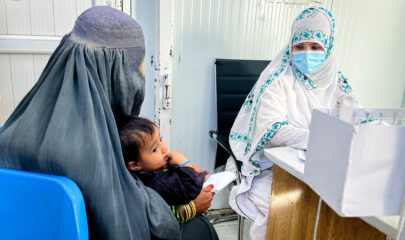According to the World Health Organization, people with disabilities represent 15 per cent of the population worldwide. This percentage is even higher in countries affected by poverty or conflict. Disability prevalence is higher for women than men in lower-income countries. Women with disabilities experience two levels of discrimination (gender and disability). Women and girls living with disabilities are particularly vulnerable to abuse and sexual violence.
People with a disability have a greater need to access health services.
After 18 years working with Doctors Without Borders/Médecins Sans Frontières (MSF), I had the opportunity to work for a Norwegian international development organization specializing in assistance for people with disabili- ties. It was a rich learning experience enhanced and maybe motivated by my own declining hearing. I revisited contexts I was familiar with through my work with MSF but from a different per- spective, with a specific focus on people with disabilities.
There, I worked closely with organiza- tions for people with disabilities (OPDs), the majority of whose staff are people with disabilities themselves. We support- ed these organizations in building their capacity to assist people with disabilities living in the communities they work with through micro projects or advocacy for better access to services.
ATTITUDES ARE ONLY ONE TYPE OF BARRIER
Through this work, I was able to better understand the high level of exclusion, discrimination and isolation people with disabilities experience in many places where MSF also operates.
But attitudes are only one type of barrier. Other barriers hamper people with disabili- ties’ access to services in general, including health services. I realized that I could have done better while I was working with MSF. I could, for example, have met with OPDs, who may have been able to offer guidance on how to improve people with disabilities’ access to MSF’s health services.
Recognizing that people with disabilities are often the most in need of medical humani- tarian assistance in the regions where MSF works, in 2016 I put forward a motion at an international assembly calling on MSF to ini- tiate action to develop awareness of the risk of excluding people with disabilities, and to put specific measures in place to improve access to the organization’s healthcare services. This included developing more sys- tematic dialogues with OPDs, making sure our structures are accessible to people who use wheelchairs and ensuring we are using different types of media for our communica- tion (audio and visual to name a few).
In early 2018, I was recruited to coordinate and launch a project on inclusion of people with disabilities in MSF.
WHERE ARE WE NOW?
Since then, tools and materials on why and how to implement inclusion have been developed and are now in use, which can be easily accessed through a dedicated online portal for MSF staff working in headquarters and projects around the world. This includes videos to raise awareness, general and tech- nical guidelines, guidelines on accessibility, reference documents and an extensive online course. The course is the result of a strong collaboration between an OPD in Malawi as the main content provider and an MSF team in Canada for the technical realization.
Since its launch, more than 15,750 users have relied on the inclusion portal devel- oped by the project and around 1,000 have visited our online course.
In Zimbabwe, knowing people with disabil- ities can be disproportionately affected by sexual violence, the MSF medical team in Harare for sexual and reproductive health found it striking no people with disabilities were using their services. To understand and bridge this gap, staff contacted OPDs, provided training on inclusion and worked on the physical accessibility of the medical centre. These three simple measures were intended to provoke a change and inspire other projects to affect change.
The MSF team in Lebanon wondered how they could set up an accessible medical structure (known locally as a family centre) when the only facility available was a multi- floor building with no elevator. How could people with a range of mobility consider- ations reach services on the third floor?
No need for patients with disabilities to go up the staircases, the medical teams would go down.
The medical and logistic teams found the solution: make the ground floor fully accessible and organize a dedicated room so the same services could be provided to people with disabilities here. There was no need for patients with disabilities to go up the staircases – the medical teams would go down to them.
“In order to honestly refer to ourselves as a family centre, it did not feel right that people with disabilities would be unable to enter our building or have a hard time doing so,” says Harald Lognvik, construction focal point in the Beirut project. “Ever since we started working on this project, including people with disabilities has been a priority.”
In projects worldwide, MSF has been col- laborating with OPDs during the COVID-19 pandemic to disseminate information about infection prevention, systematically using two methods of communication (au- dio and visual – radio and posters). Using local sign language in awareness-raising videos has also been emphasized. It is also the first time an MSF project has developed health promotion materials in braille, in Democratic Republic of Congo.

© Louise Limela / MSF


